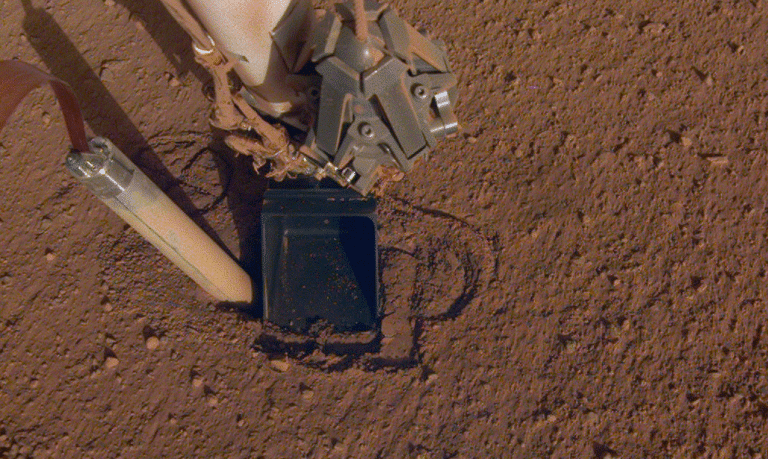It looks like the InSight Lander’s Mole instrument is making some progress. After months of perseverance, the team operating the instrument has succeeded in getting the Mole at least some distance into the ground.
That is a victory in itself, considering all the setbacks there have been. But it’s too soon to celebrate: there’s quite a ways to go before the Mole can deliver any information.
The Heat Flow and Physical Properties Package or HP3 also known as the Mole is an important scientific equipment on board. Its job is to penetrate into the Martian soil, to a depth of 5m (16 ft.) The idea is to place the Mole’s series of embedded heat sensors into the soil and measure the heat coming from the interior of Mars. The Mole will measure the increase of temperature with depth, called the geothermal gradient, and thermal conductivity. Multiplying those two values give the heat flow.
By studying the thermal processes in the interior of the planet, scientists can learn a lot about the history of Mars and how it formed. They may also gain insights into how other rocky bodies formed.
The Mole was designed and built by the German Aerospace Center, or DLR, as their contribution to the InSight mission. It can gather some useful scientific data from a shallower depth than its maximum of 5 m. At about 3m, it’s deep enough that seasonal changes won’t affect the data. But as of now, it’s nowhere near deep enough.
In May NASA announced that they were using the scoop on the end of InSight’s robotic arm to exert downward pressure on the Mole. That was risky since the Mole’s wiring harness is on the top, where the scoop needed to exert pressure. Damage the harness and that could spell the end.
This is schematic of the estimated temperature profile of Earth. On Earth, the heat has several causes, including the decay of naturally radioactive elements. The Mole’s job is to begin to piece together a similar profile for Mars. pic.twitter.com/YlR6vwD9xL
— The Science Thinkers (@ScienceThinkers) June 15, 2020
But NASA and DLR personnel were between a rock and a hard place. A type of compacted soil called duracrust was preventing the hammering action of the Mole from penetrating the soil. They were running out of things to try.
Using the instrument arm scoop to get the Mole into the ground is a victory of sorts, but the method has limitations. Once it’s buried, the arm’s scoop can no longer apply any downward force to the submerged instrument. Now the Mole has to resume the hammering motion that it uses to work its way into the ground.
Mission personnel saw this moment coming, back in May, when they took the calculated risk of pressing down on the Mole with the instrument arm scoop. They knew that if that worked, it would not be a complete solution. They could use the method to get the Mole started, but now it’s up to the instrument’s self-hammering motion to drive the Mole deeper.
The Mole relies on friction between itself and the soil to drive itself into the ground. The duracrust prevented that from happening, because it was too solid to fall into the Mole’s hole, filling it and providing the necessary friction. If the Mole is now deeper than the problematic duracrust, there might be enough friction for the Mole to continue downward.
NASA and the DLR deserve some credit for this demanding troubleshooting situation. They’re about 225 million km (140 million miles) away, trying to figure out what to do. They have testbeds here on Earth, with replica landers, that they use to work their way through situations like this.
So even though this latest announcement represents some progress, there was no way to predict the duracrust and what it meant for the Mole. The future is still uncertain.
